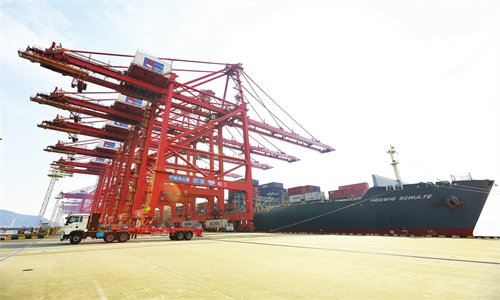
Illustration: Chen Xia/Global Times
China's population decreased by 850,000 in 2022 to 1.411 billion, the National Bureau of Statistics (NBS) said at a press conference earlier this month, which also revealed the country's GDP reached about $18 trillion last year. The population size recorded its first drop in the past six decades, which immediately set off a frenzy of Western media coverage heralding the "dire implications" for the world's emerging economic and political power.
It's laughable that the mainstream media in the US caught the news, kept spinning on it, and even created a new narrative that "the decline of China is undeniable and irreversible." Some media pundits there even penned opinion pieces asserting that "China will become older before it becomes richer," and from now on, "forget about a rising China."
But demography is not destiny. The small dip in population size won't spell doom for China's rise and the Chinese people's steadily growing fortunes. Before 2050, it's highly unlikely that China will face a "demographic disaster" that the country will fall short of manufacturing manpower, because the government has many tools to encourage birth of children and readjust population structure.
Moreover, China has already begun to pursue industrial and services automation through vigorously deploying robotics, big data and artificial intelligence. It is a desirable development for the country to seek growth through other sources such as enhanced productivity aided by technologies.
The new mantra coming from government officials and economists is seeking "smarter, more efficient, high-quality growth," while not "addicted to past labor intensive low-grade manufacturing and processing." Also, from the perspective of planetary environmental sustainability, an ever-growing population on Earth surpassing 8 billion or 10 billion is never a good thing.
Last year, China registered new births of 9.56 million babies, a number that far outstrips combined new births in 27 EU countries and the US. In the foreseeable future, China will not face a population crisis as alleged by some Western media pundits. Chinese economists point out that the country has a large pool of rural labor that could help fill assembly line gaps in urban factories.
According to official data, the unemployment rate for the age group of 16-24 years old in China is 16.7 percent at the end of 2022 - meaning the country is not short of young workers at all, and the government may not rush to prolong the retirement age for Chinese workers. Currently, the retirement age for men is 60 years old, and for women is 55 years old (for blue-collar women workers is 50 years old).
In the next several years, the number of college graduates is estimated to hover at 10 million each year, providing sufficient human resources to support economic growth, which also indicates that the country's demographic dividend is shifting from quantity to quality. The NBS announced China's yearly GDP grew 3 percent in 2022, with per capita GDP hitting $12,741, meeting the standard of medium developed countries.
Most economists have forecasted that China will significantly regain growth momentum this year, with the economy likely to grow by 5-6 percent. Barring any abrupt mishaps such as a resurgence of COVID-19, the economy size of China will most likely surpass $20 trillion in 2024. The assertion that the population drop will upend China's economic rise will prove to be American wishful thinking, and another try at "China collapse" - a falsified theory the world has heard many times in the past 40 years. It has a sister theory called "China threat," which is also untenable.
Certainly, China's population decline is worth the attention of Chinese policymakers. The 20th National Congress of the Communist Party of China, convened in October, took note of the demographic change, stressing that the country will do its utmost to establish a new policy structure to boost fertility and birth rates through reducing the costs of pregnancy and births, child rearing and schooling from kindergarten to college.
Since then, many local governments have started to offer more generous cash handouts, housing allowances and tax breaks to married couples willing to have two or three children.
It is believed that the authorities at different levels this year will put in place more preferential measures to usher in a complete set of policies that significantly incentivizes and encourages larger families. The effect of the policy pivot will be gradual. China has become a highly digitalized and relatively affluent society, in which young women have progressed in independence and self-esteem, who now want to have fewer children so that they could have more time to pursue professional achievements.
It is likely that the country may witness a few years of stabilizing when it comes to the number of births, or even see a short-term return to population growth after the impact of the pandemic subsides following the country's lifting of COVID restrictions. Also, the government has plenty of time and resources to manage the stall in population growth, including new national legislation to raise the retirement age, which will make a better use of human resources and delay the formation of an ageing society.
To summarize, neither a shrinking nor a growing population represents a crisis in itself. Focusing on population numbers to make wild predictions will risk missing the forest for the trees. The far more important issue is that the government shall respond quickly and effectively to the challenges. China's population decline will be mild and the country's economy will just keep expanding, backed by sufficient and better-educated work force.
The author is an editor with the Global Times. bizopinion@globaltimes.com.cn


